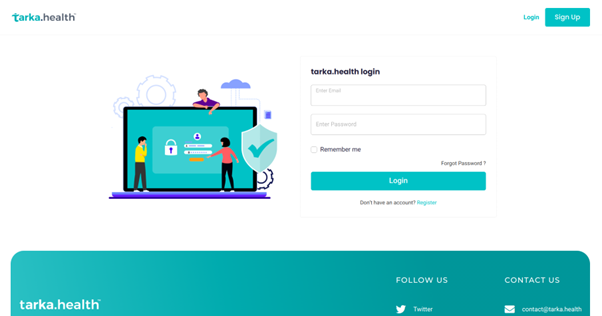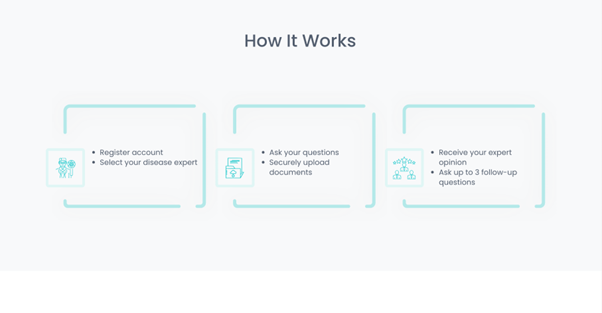
Telehealth Platform
A telehealth project that connects patients with the right doctors in the US. All doctors go through the validation of documents and specialties confirming their experience. The point of the project is that patients from all over the world can pay and ask questions to highly qualified specialists, and doctors themselves can earn extra money by spending a minimum amount of their time.

Target Audience
Patients around the world who need to get advice from professional American doctors.
The main tasks and challenges
What did the client come to us with?
We were approached by a client from the USA, who also works in healthcare as a doctor and also wants to help patients from many countries around the world. The client had just an idea. There was no design or technical documentation – only examples of competitors. The client initially came to us through Upwork, we wrote a cover letter and showed relevant experience, which we have quite a lot since the functionality that should be in the project is shopping and chat options. We already did the WriterLink social network, where there are chats and other functions. Accordingly, we have already made most of the similar functionality. The client paid attention to our skills and experience and chose us for this.
Our assessments
Of course, first of all, our project manager gathered all the requirements that the client had. He refined them and involved programmers in it. When all the requirements were finalized and reviewed by the client, we formed the technical documentation from the beginning (planning of the client’s architecture) to the conditional implementation of the project. We have described each point and each role in this technical task. And, after that, we additionally created a diagram, a site map, where all user roles are shown – a patient, a doctor, and an administrator. For each of the roles, it was shown what this role interacts within the project, with which pages, and what it can do on these pages.
The estimate was $23,000 for the entire project, completely from scratch. In addition to the assessment itself, we also chose a template. We bought a ready-made template for the project so we could not spend money on designing a custom one.
Technologies list
After all, a project related to medicine must be safe. If people are always sick, then there will always be an influx of customers. So, we focused on the fact that the site and the architecture of the project itself would be flexible and could develop further. At the same time, we developed a flexible and strong web solution architecture that could handle severe levels of load.
With a large load on the project, we made the architecture and environment of the project such that it would expand, depending on the load. We used technologies here like the latest versions of Laravel and Vue.js. And, of course, the most important technology is Stripe to process the payments that the patient makes to buy a paid question to the doctor and then they get a response from the doctor.
Design
During the development process, we discovered that the default template did not quite meet our and our clients’ needs. And we brought our designers to work on this template. During the development process, the template was refined and customized. A rather unique design was obtained, which can now be seen on Tarka Health. For the design, we used Figma to customize the template.
Edits to the schedule were, again, made by the task pool in Trello. Also, with the help of Kanban, we divided everything into processes to understand at what stage design changes are being made. And it was always obvious when the design would be ready.
Development team
The level of developers was middle plus. Two developers worked on the project – Oleksandr Skrypnyk and Stanislav Tsaplin. The process was divided into different roles, they shared their responsibility. For example, Sasha worked on the role of a patient, and Stas worked on the role of a doctor. Some features overlapped: someone was engaged in both roles, but the work was coordinated so that the guys were always aware of who they were doing. So, there were no conflicts, and they used the same programming standards that would coincide with our requirements. In addition, the team also consisted of a technical leader, two QA testers, and a designer.
The main development process
Detailed description of the development
We managed the project using Agile and Kanban. And, accordingly, the tasks were carried out according to these processes, and the whole work was tracked in segments. For example, when we completed the payment module, we checked how it works. And, thus, additional reports were also formed. That is, there was an additional system – well, systematization. The client always knew which part of the functionality we were working on in the next two to three weeks. The performed work was presented to them in the form of video reports. We show them how far we have moved on budget and time.
Reports were presented every Friday. Meetings and tours of the project were held once a week, once every two weeks.
Development Process
Services such as Pusher were used for reactivity and getting notifications in real-time without rebooting the system. It’s especially useful for developing online chats, making them work correctly, and providing quick patient-doctor communication. Among the other tools we used are also Jira, Confluence, Excel, and MindMeister.
After that, we deployed the project infrastructure and completed the entire task pool according to client requirements and within the established budget. Finally, we completed coverage of the project with Unit and QA tests.
Development terms
The initial estimated time was 774 hours. We managed to complete the project in 5 months.
The client contributed some changes during development. Sometimes, they didn’t like the design, and we reworked it. They changed the original idea for some features, but they listened and those changes weren’t too critical. We controlled the changes so that they wouldn’t affect the project’s architecture and structure. So that there are no major revisions. Luckily, there were no critical pitfalls, everything was okay.
Solution
The telehealth platform was created for people around the world, so they could go to this site and consult with qualified, certified doctors from the USA. The main advantage of this platform is that a patient can skip traveling to America to consult a professional. They can simply go to the site, create an account, choose a doctor, fill out a complete question, provide all the necessary documents, and pay for the conversation with the doctor.
After that, the doctor answers patients’ questions, and if the answer is not sufficient, the patient will have the opportunity to ask additional questions in the chat. And, after that, the doctor forms the final answer and additional advice. For example, they may recommend you visit a doctor, take an X-ray, and other recommendations that may help patients conditionally understand in which situation they are. This online project will help patients contact professionals and receive proper advice. In addition, besides chats, you can also get video calls and video advice.
Customer feedback
The client is satisfied with the project, they are currently conducting a marketing campaign, and we are currently supporting the project.
Technologies
- Laravel
- Vue.js
- PostgreSQL

